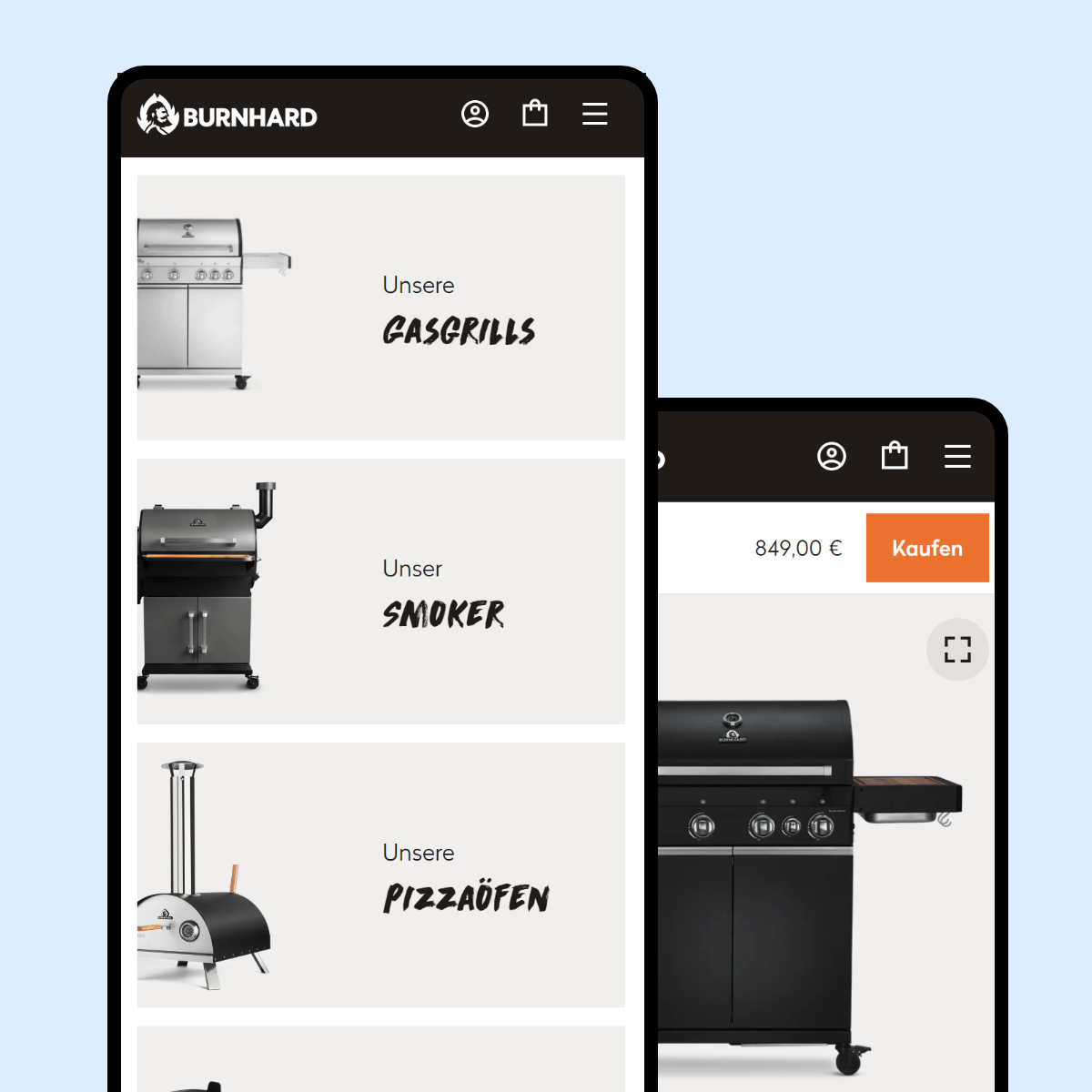How our TCO calculator works
At Code, we understand that calculating the costs of a new platform can be a daunting task. We often speak to brands who feel somewhat lost, because in Shopify’s extensive app ecosystem fees are often hidden behind a ‘starting at X’ or ‘Talk to us’ button. This is exactly why we build our own Shopify TCO calculator.
Our TCO calculator includes:
- Monthly Shopify fee (Shopify Advanced or Shopify Plus). See here a complete Shopify price overview.
- Monthly fees of most commonly used third-party apps: Klaviyo (Email), Gorgias (Customer Support), Rebuy Engine (Personalization), LoyaltyLion (Loyalty), Reviews.io (Reviews)
- Development costs of initial build (Choose between Base/Advanced/Enterprise project)
- Monthly development costs (retainer)
- Your TCO as a gross merchandise value (GMV) percentage
The TCO calculator does not include payment transaction fees as this is very dependent on your chosen PSP + the rates you negotiated. If you would like some expert help with this, get in touch with our co-founder Bob Rockland here.
Disclaimer: Our calculator offers guidance, not guarantees
We built our Shopify TCO calculator with considerable attention to detail, intending to provide you with as much guidance as possible. In addition, we aim to give you a tool to practice with, to get a feel for the dynamics between the various costs that are laid bare through a TCO calculation. However, the calculations presented are still estimations - not exact results that apply one on one to your specific needs and situation. This is why we cannot provide any guarantees as to the accuracy of the numbers provided.
Changes to the pricing of any of the partners presented in this calculator are expected from time to time, so the results generated by the calculator may also vary over time. Code will make an effort to provide up-to-date pricing data and currency conversions.
Are you serious about getting the TCO for your brand right, and would you like to get full insight into the calculations behind this calculator? Send us an email at bob@code.nl, we’re here to help!
What is Total Cost of Ownership (TCO) and why is it important?
Are you new to the concept of TCO? Let’s give you a quick introduction: a TCO calculation gives you an overview of the costs of implementing and maintaining an e-commerce platform over a given period of time – typically 3 to 5 years. It includes all costs involved in running your online store: building it, using it, maintaining it, and scaling it.
For e-commerce brands considering a migration to another platform, knowing the TCO of various platforms and being able to compare them on cost is necessary to make an informed decision. A good TCO calculation will also reveal ‘hidden’ costs, like third-party apps, payment transaction fees and other things you could overlook when assessing a platform.
What should be included in a TCO calculation?
A TCO calculation for e-commerce platforms consists roughly of two cost categories: the cost of the initial build + the cost of day-to-day operation and maintenance after that.
1. Cost of initial build
-
Design
-
Development of your online store
-
Development of integrations (PIM, ERP, WMS) and custom-built features like configurators
-
Any one-off fees paid to the platform, third-party apps and extensions
-
The cost of setting up hosting, servers and other hardware (such as POS) needed to run your store (only if you are not on SaaS)
2. Recurring platform costs
-
Platform fees (e.g. Shopify Plus fee)
-
Payment processing fees (e.g. Mollie, Shopify Payments)
-
App fees (e.g. Klaviyo, Gorgias)
-
Integrations fees (e.g. PIM, ERP, WMS)
-
Future feature development & retainers with your development agency
-
Hosting (only for non-SaaS platforms)
-
Platform upgrades and maintenance (only for non-SaaS platforms)
Calculating costs: Open source VS SaaS
When you calculate the TCO for non-SaaS platforms (such as Adobe Commerce, Magento, Shopware and WooCommerce) you will have to include several things that are absent from the TCO calculation for SaaS platforms like Shopify:
- Setting up hosting and servers (including the cost of backup servers)
- Hosting fees
- Platform upgrades and updates, security updates, and platform maintenance
- The cost of your DevOps team (in-house or agency) needed for server management
- The cost of scaling issues, e.g. managing expected (BFCM) and unexpected sales peaks
- The cost of troubleshooting and crash management
- The cost of any overhead to do with platform support (any unexpected errors you need developers for)
- If you want to get the complete picture, you can also factor in the estimated cost of missed revenue due to crashes and errors
Including payment transaction fees in your TCO
With any platform, SaaS or non-SaaS, the bulk of your operating costs will be coupled to your revenue - in the form of revenue sharing (in the case of Shopify’s subscription model) and, most importantly, the transaction fees charged by your Payment Service Provider (PSP). This means that, with the exact same platform setup, the TCO for a brand with 5 million yearly revenue will be lower than the TCO of a brand doing 50 million a year.
It also means that it pays off to pay close attention to how you set up your transactions. Most payment methods charge a fee, for instance a credit card rate (usually consisting of a small percentage plus a set amount), which can differ between PSP’s. On top of that your PSP will also charge a transaction fee for the use of their service. When you’re on Shopify Plus, for example, this gives you the following options:
-
Payment Service Providers: If you opt for a third-party PSP like Mollie, Shopify charges an additional platform fee of 0,15% (Shopify Plus) or 0,5% (Shopify Advanced) for every transaction made via that PSP. Still, using a third-party PSP can be interesting for your business if you have a lot of negotiation power and can broker a nice deal with your PSP. Often, Shopify Payments rates are higher than those of other PSPs - which is another reason to keep an eye on your TCO calculation.
-
Shopify Payments: The rates per payment method that Shopify Payments charges depend on your Shopify plan (Basic, Advanced or Plus): the higher the plan, the lower the rates charged for the use of creditcards, iDeal and other payment methods. If you use Shopify Payments, Shopify will not charge you an additional platform fee (as you would have if you use an external PSP: see above).
How Shopify lowers your costs and maximizes your profits
Over the last 6 years, Code launched +/- 250 brands in the Benelux, DACH, UK and Nordics on Shopify. The majority of these brands mention Shopify’s lower TCO as a core reason to switch platforms, alongside performance and functionality.
→ BURNHARD (Shopware 5)
→ Le Nouveau Chef (Shopware 6)
→ namuk (Magento)
→ Trimtex (Salesforce Commerce Cloud)
Here’s an overview of reasons why Shopify costs are lower than most commonly used E-Commerce platforms:
- No hosting and security costs: As Shopify is a hosted SaaS solution, hosting costs are included (no headaches to manage and maintain servers) and Shopify takes care of security compliance, SSL certificates, and data protection.
- Scalability: Shopify (Plus) allows for easy scalability, enabling store owners to expand their businesses without significant increases in cost or complexity. This is particularly true with Shopify Plus, which is designed for high-volume merchants.
- Fast Time-To-Market: Working with a Shopify theme allows you to develop fast and cost-efficient. At Code, we built all our shops on our own Code Base Theme, containing all our best practices - which is even faster and more cost-efficient.
- Less need for custom code: Shopify offers many built-in functions and its extensive app ecosystem allows you to add store functionality without the need for custom development.
- Content management: The ease of content management on Shopify reduces the time and resources required to maintain your website, including managing multiple international stores.
- Updates & Maintenance: Shopify automatically rolls out updates and takes care of maintenance, meaning you will never face an End of Life (EOL) or forced security update.
- Internationalization: Shopify’s options for multi-language / multi-currency stores make it cost-effective to reach global markets.
Get in touch with Code
With the prospect of higher performance, lower platform costs and project timelines being as short as 3-6 months, a Shopify Plus migration can be an attractive move for your brand.
Would you like to sit down and talk to one of our experts about a potential Shopify migration for your brand?
Fill in our contact form and we will get in touch with you within one business day.



